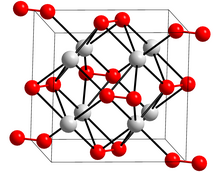Potassium peroxide
Appearance

| |
| Names | |
|---|---|
| IUPAC name
Potassium peroxide
| |
| Identifiers | |
3D model (JSmol)
|
|
| ChemSpider | |
| ECHA InfoCard | 100.037.339 |
| EC Number |
|
PubChem CID
|
|
| UNII | |
CompTox Dashboard (EPA)
|
|
| |
| |
| Properties | |
| K2O2 | |
| Molar mass | 110.196 g/mol |
| Appearance | yellow amorphous solid |
| Melting point | 490 °C (914 °F; 763 K) |
| reacts with water[1] | |
| Structure | |
| Orthorombic | |
| Cmca, oS16 | |
| Thermochemistry | |
Std molar
entropy (S⦵298) |
113 J·mol−1·K−1[2] |
Std enthalpy of
formation (ΔfH⦵298) |
−496 kJ·mol−1[2] |
| Hazards | |
| NFPA 704 (fire diamond) | |
| Related compounds | |
Other anions
|
Potassium oxide Potassium superoxide Potassium chloride |
Other cations
|
Lithium peroxide Sodium peroxide |
Except where otherwise noted, data are given for materials in their standard state (at 25 °C [77 °F], 100 kPa).
| |
Potassium peroxide is an inorganic compound with the molecular formula K2O2. It is formed as potassium reacts with oxygen in the air, along with potassium oxide (K2O) and potassium superoxide (KO2).

Potassium peroxide reacts with water to form potassium hydroxide and oxygen:
References
- ^ Lide, David R. (1998). Handbook of Chemistry and Physics (87 ed.). Boca Raton, Florida: CRC Press. pp. 477, 520. ISBN 0-8493-0594-2.
- ^ a b Zumdahl, Steven S. (2009). Chemical Principles 6th Ed. Houghton Mifflin Company. p. A22. ISBN 0-618-94690-X.


